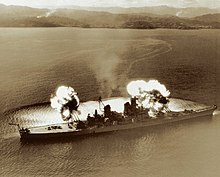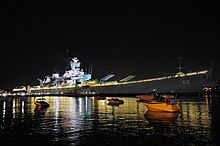USS New Jersey (BB-62)
Her secondary battery consisted of twenty 5"/38 caliber guns mounted in twin-gun dual purpose (DP) turrets, which could hit targets up to 9 miles (16.7 km) away.
Her first action as a flagship was in Operation Hailstone, a two-day surface and air strike by her task force against the major Japanese fleet base on Truk in the Carolines.
In this span of the Pacific War, fast carrier task forces ranged the waters off the Philippines, Okinawa, and Formosa, making repeated strikes at airfields, shipping, shore bases, and invasion beaches.
[8] During the final months of the war, New Jersey was overhauled at Puget Sound Naval Shipyard, from which she sailed 4 July for San Pedro, Pearl Harbor, and Eniwetok bound for Guam.
Brief stays at Manila and Okinawa preceded her arrival in Tokyo Bay 17 September, where she served as flagship for the successive commanders of Naval Forces in Japanese waters until relieved 28 January 1946 by Iowa (BB-61).
[8] Aside from a brief break in firing 23 September to take aboard wounded from the Korean frigate Apnok (PF-62), damaged by gunfire, New Jersey was heavily engaged in bombarding the Kansong area, supporting the movement of the U.S. X Corps.
Enemy bunkers and supply concentrations provided the majority of the targets at Kansong; at the others New Jersey fired on railroads, tunnels, bridges, an oil refinery, trains, and shore batteries.
[8] Relieved as flagship by Wisconsin, New Jersey cleared Yokosuka for Hawaii, Long Beach and the Panama Canal, and returned to Norfolk 20 December for a six-month overhaul.
Between 19 July 1952 and 5 September, she sailed as flagship for Rear Admiral Harry R. Thurber, who commanded the NROTC midshipman training cruise to Cherbourg, Lisbon, and the Caribbean.
[8] Shaping her course via the Panama Canal, Long Beach, and Hawaii, New Jersey reached Yokosuka 5 April, and next day relieved Missouri as flagship of Vice Admiral Joseph H. Clark, Commander 7th Fleet.
[8] At sunrise on 25 July 1953 New Jersey was off the key port, rail and communications center of Hungnam, pounding coastal guns, bridges, a factory area, and oil storage tanks.
She sailed north that afternoon, firing at rail lines and railroad tunnels as she made for Tanchon, where she launched a whaleboat in an attempt to spot a train known to run nightly along the coast.
[16] In August 1967 the Secretary of Defense made the decision to recommission a battleship "for employment in the Pacific Fleet to augment the naval gunfire support force in Southeast Asia".
Foul weather prevented spotter aircraft from flying until 20 October; however, New Jersey quickly made up for lost time on the gun line by destroying a Viet Cong command post and nine bunkers in support of the 173rd Airborne Brigade, who were operating about 50 miles (80 km) north of Nha Trang.
The next day New Jersey maneuvered into the waters of the Baie de Van Fong to fire at Viet Cong command posts, but poor visibility of the target area prevented any damage estimates.
[20] Upon completion of this mission New Jersey steamed south, taking a position off Da Nang and Point DeDe to lend naval gunfire support to the U.S. 1st Marine Division operating in the area.
For the next three days New Jersey fired her guns to support the II Corps, in the process destroying Viet Cong bunkers and supply depots and neutralizing enemy cave posts.
The next day New Jersey fired on an enemy rocket site northeast of Con Thien, destroying the facility, then trained her guns on known Communist positions to harass PAVN forces.
On 17 December 1969 New Jersey's colors were hauled down and she entered the inactive fleet, following the words of her last commanding officer: "Rest well, yet sleep lightly; and hear the call, if again sounded, to provide fire power for freedom.
Preliminary modernizations schemes included the removal of four of the ten 5 inch gun mounts on New Jersey to make room for the armored box launchers that would be required to carry and launch the BGM-109 Tomahawk missiles.
In August 1983, Israel withdrew its Defense Forces from the Chouf District (southeast of Beirut), thus removing the buffer between the Druze and the Christian militias, triggering another round of brutal fighting.
[35] United States Navy warships shelled Druze positions and helped the Lebanese Army hold the town of Suk El Gharb until a cease-fire was declared on 25 September, on which day the battleship New Jersey arrived on the scene.
[38] Carrying on a tradition he had begun in World War II of spending Christmas with U.S. forces overseas, Bob Hope and his troupe of entertainers gave a show aboard the New Jersey on 24 December 1983.
An investigation into New Jersey's gunfire effectiveness in Lebanon, led by Marine Colonel Don Price, found that many of the ship's shells had missed their targets by as much as 10,000 yards (9,140 m) and therefore may have inadvertently killed civilians.
"[44][45] The inaccuracy is believed to have resulted because the ship's main gunpowder had been remixed by the Navy, under the direction of Captain Joseph Dominick Miceli at the Naval Weapons Support Center, and rebagged.
[47] This was first time that New Jersey had operational control of her own group of escorts since the Korean War, and she cruised from Hawaii to Thailand in 1986, freeing up U.S. aircraft carriers for other missions and in the process becoming the only major U.S. naval presence in the region from May to October.
[49] According to a declassified command history for the nuclear-armed battleship New Jersey, during her transit through the Sea of Okhotsk on 27–28 September 1986, "close passes" were made by Soviet Bear and Badger bombers, a Hormone helicopter, and a May maritime patrol airplane.
The decision to decommission New Jersey robbed the battleship of the chance to participate in Operation Desert Storm in 1991, a military campaign to forcibly remove Iraqi troops from Kuwait.
Secretary of the Navy Richard Danzig made the announcement on 20 January 2000,[56] and on 15 October of that year New Jersey arrived at her final resting place on the Camden Waterfront.
One of USS New Jersey's original gun barrels from 1943 to 1954 now sits on the northwest corner of the Marine Parade Grounds alongside Broad Street and Intrepid Avenue in Philadelphia.

















